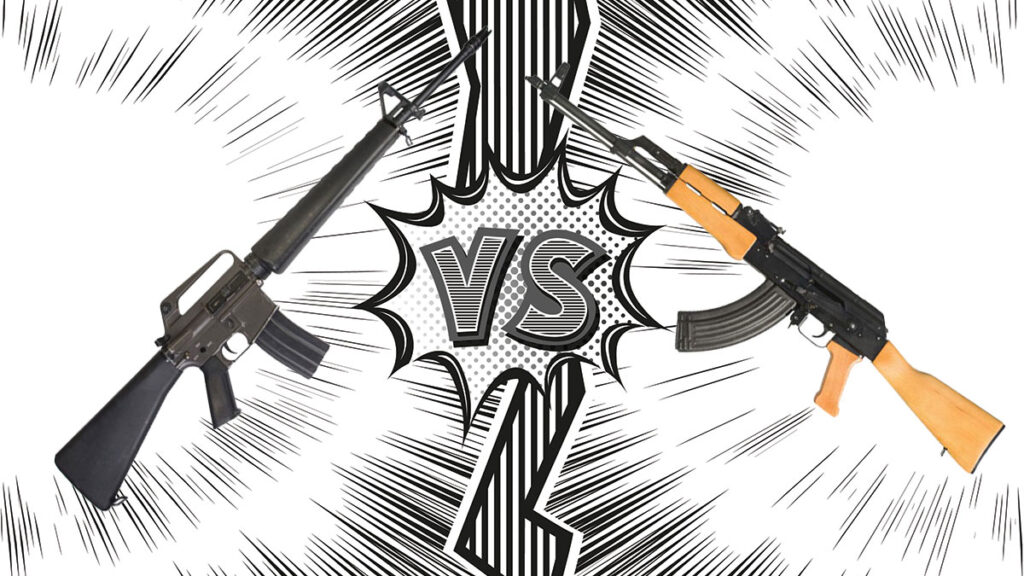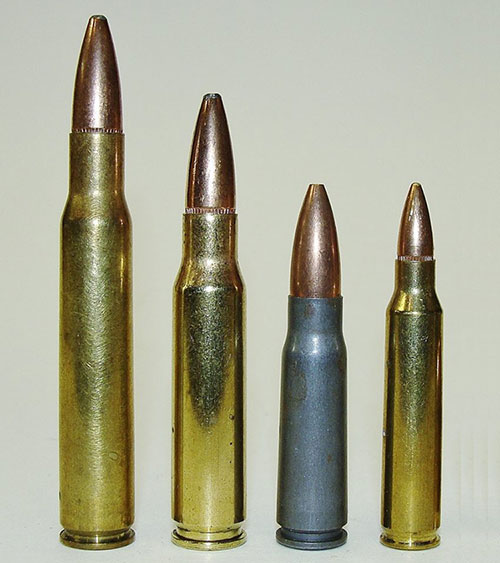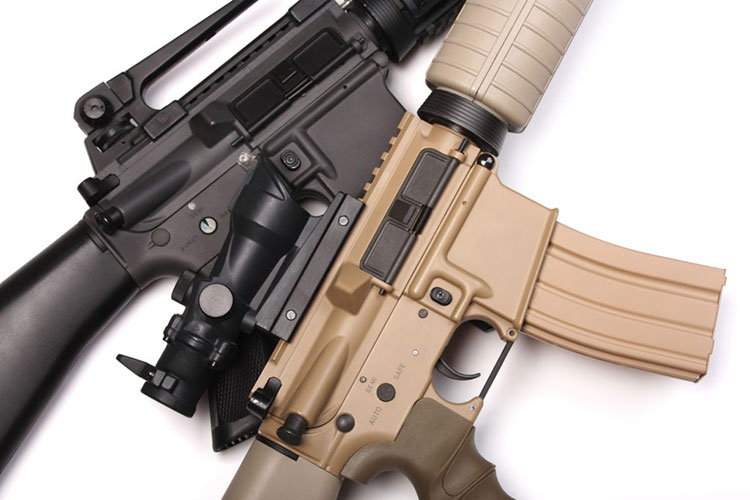
Aerospace Aristocrat Versus Hard-hammering Farmhand
(AR-15 vs AK-47)
I still vividly remember my first hands-on encounter with Mr. Stoner’s Armalite Rifle. Upon entering the bowels of a dimly lit armory at Fort Benning, scores of black rifles materialized, all neatly lined up in racks. At that time, the M-16 was much less common stateside and I was taken aback by the rows of futuristic weapons. Conspicuously absent were sturdy walnut stocks and strong steel actions; reassuring hallmarks of the M-14 rifle. By comparison, the racy M-16s looked as sinister as cold-war spies in black overcoats.
My Introduction to the Avtomat Kalashnikova
A few months later, during the very first few days of 1969, I had an opportunity to lay my mitts on an Avtomat Kalashnikova – better known as an AK-47. The contrast couldn’t have been more stark. I was one of around one-hundred green Army replacements participating in a two-week, in-country jungle survival school.
Because it was live theater, “participation” was a better description than attendance. Hosted by the 4th Infantry Division in the rugged Central Highlands of Vietnam, the active war zone provided a realistic backdrop, complete with incoming pyrotechnics. Familiarization with enemy weapons had its share of surprises.
A crusty old NCO (actually, probably in his 30s) produced an extremely beat up AK and, without warning, proceeded to pour a 30-round full-auto barrage into a steel drum. The Chicom battlefield pickup never skipped a beat and the drum came up the clear loser.

I was itching for a close look and, surprisingly, the NCO obliged. Beyond the AK’s numerous dents and bruises, this specimen was plastered with the same red clay that all who trod Pleiku learned to despise. Turned out, the 4th ID cadre intentionally left it in this condition just to prove a point; namely, an AK will run!
More AR-15 vs AK-47 Contrast
We were threatened with summary execution for even considering such neglect to our M-16s. The word was, keep it clean, properly lubed, and feed it good ammo. Do that and it’ll run. This was after the period when the M-16 had problems. Some of our instructors were on a second tour and were familiar with its early faults. We scrupulously cleaned our new M-16s after each daily march to a makeshift range, located well outside the wire of the firebase.
Serving as further incentive, because the hike was actually a war patrol, our M-16s were carried locked and loaded (sometime later, a perforated NVA soldier was discovered behind a target backer). The good news was our rifles were indeed reliable. But, still there were M-16 skeptics. Not all were newbies either.

At that time, many older soldiers had cut their teeth on a full-fledged battle rifle. For some, it was an 8-shot M-1 Garand chambered for the mighty .30/06. Newer troops, including me, slogged through Basic with the M-14; a 20-round, magazine-fed evolution that fired the respectable 7.62×51 (or .308) round.
For those from that era, first impressions of the M-16 were troubling. One concern was the puny 5.56 cartridge. Another was the plastic furniture which, when compared to its brawny predecessors, lent a toy-like aura to the new-fangled lightweight rifle (rumor was the stocks came from Mattel).
Of note, the AK invoked no such complaints. It might not have been pretty but it did look and feel like a serious threat. Most of us failed to grasp the rationale for the Army’s new M-16, which was adopted to counter an emergent threat.
The AK-47 Family Tree

A flashback to the STG-44: During WW II, the Germans recognized the need for firepower and maneuverability. The answer was what we today call an “assault rifle.” The compact STG-44 offered controllable full-auto fire through use of shortened 8mm cartridges fed from 30-round magazines.
At first glance, it would be easy to mistake one for an AK-47. The latter’s designer, Mikhail Kalashnikov, claimed they were unrelated. Maybe, but there are clear similarities:
- One is the AK’s short 7.62×39 cartridge, which looks a lot like a German 8mm Kurz (or short).
- Neither offered the effective range of their full-size parents but both were vast improvements over pistol-caliber submachineguns.
- Effective out to around 400 yards, these select-fire assault rifles with their 30-round magazines could greatly boost the firepower of an infantry squad without the need for a larger automatic rifle – like the .30/06 BAR.
The U.S. took notice and sought a solution of their own.
The M-14 “Solution”

The supposed fix was the M-14, an evolution of the Garand with a select-fire capability that could deliver 20 full-auto .308 rounds. Sounds good in principle, but control was a different matter. I rarely saw one fired on full-auto, but the first event was memorable.
After ripping off a 20-round burst, a tell-tale cloud of dense white smoke billowed from underneath the handguard (possibly from oil, burning wood, or both). No telling where the last dozen or so bullets struck – other than “high.”
Evolution of the AR-15
After recalling the M-14 episode, I took a closer look at my new M-16 and saw the benefits in a new light:
- Its “puny” 55-grain 5.56 rounds generated less heat and the metal-lined plastic forend was smoke-proof.
- Stock warpage was a non-issue and semi-auto accuracy was consistently good.
- In full-auto, the straight-line design was touted as a superior for mitigation of recoil, which turned out to be true.
- Muzzle climb was further reduced by use of the small cartridge; effective through a combination of high-velocity and firepower.
- Reloads were nearly instantaneous and the 20-round magazines issued at that time were small enough to be carried in large quantities (my basic load consisted of 15 magazines).
- And, with every ounce counting in the tropical heat, the rifle’s light weight was a blessing.
Another concern was rust. Both were addressed through the extensive use of aluminum. The barrel was steel but its chrome-plated bore prevented pitting. Maintenance was still essential, but the M-16’s guts could receive quick attention by simply popping the rear receiver pin.
These advantages became more apparent as time in the bush accumulated. For what it’s worth, they’re still valid today.

Since then, the system has undergone steady improvements. One feature I don’t miss is the emblematic carry handle that continued into the A2 design. G.I.s often toted an M-16 like a suitcase with the muzzle sweeping everything in its path. This appendage also housed the rear sight, providing the necessary height above the stock for a cheek-weld.
However, after sunset the sights became useless. At that point, the extreme height of a shooter’s eye above the barrel made point-shooting difficult.
Today’s flat-top versions solve this issue nicely through illuminated optical sights, which permit rapid, 24/7 target acquisition. Broken handguards were common, but aluminum free-float tubes now solve this problem, with lots of room for accessories. The original pronged flash-hider hooked on brush, but today there are dozens of others to choose from.
One issue inherent to the design is sight offset. The bore sits so low that it’s easy to drill a cover-edge at close range – and hard surfaces can shoot back!

Overall though, it’s fair to say today’s AR has matured to levels previously unimaginable. Stoner’s design is not only still in service, but has risen to the status of “America’s Rifle” in civilian AR-15 form. Available in a growing list of calibers, it’s also the ultimate transformer.
Reconfiguration is as simple as retracting two receiver pins. At that point, the entire upper-receiver assembly can be removed and exchanged for another, without any loss of zero. The lower receiver is the serial-numbered “firearm,” which means uppers can be purchased by mail.
This flexibility, combined with improvements to the original 5.56 NATO load, have expanded the system’s usefulness to law enforcement groups and civilians. Misinformation to the contrary, the semiautomatic AR legitimately covers many sporting needs. One ironic point though; despite considerable efforts to improve its original 5.56 punch, practical AK-equivalent .30-caliber loads are a fairly recent development.
Evolution of (or lack of) the AK-47
Meanwhile, the AK soldiers on as it has for many decades. The history of the NCO’s AK-47 in the training I mentioned earlier would be fascinating. It was probably carried down the Ho Chi Minh trail amidst monsoons and mud, with little or no relief from the elements. Same story for its ammunition which was typically steel-cased and protected by lacquer. Maintenance would’ve been spotty due to life on the move.
Upon arrival in the rugged highlands, it no doubt saw plenty of action. There’s also a fair chance it went through a succession of users since the NVA took great pains to recover these weapons. Like numerous other battle-scarred AK-47s, its field-time probably amounted to years. We captured not only select-fire AKs, but also semiauto SKS carbines which used the same ammo. I thought about bringing an SKS home, but at that time, 7.62×39 Russian rounds were scarcer than chicken lips.
Boy, has that ever changed! The U.S. is now full of semiauto AKs, sourced from various nations, as well as several domestic brands. Unlike today’s ARs, most are configured as they were seventy years ago. More often than not the furniture is still wood. The more costly versions use milled receivers, but many others are steel stampings. Either way, rivets help hold everything together.
People trick-out AKs to some extent, but in-depth conversions are gunsmithing projects. Magazine-insertion is a bit fiddly and, unlike the AR, there is no last-shot lock-back feature (which rules one out for me).
Operation of the safety is a bit awkward, and it can be noisy unless disengaged with care. The charging handle reciprocates with the bolt, which eliminates the need for a forward-assist, however it can get snagged on digits, gear, or cover. And because the bolt can’t be retracted with the safety on, the chamber must be cleared in “fire” mode.
But cleaning is a snap. The top of the receiver pops right off for easy removal of the recoil spring and bolt, etc. Exterior surfaces become tired over time, but chrome plating protects the bore and gas system.

Ammo seems to come from everywhere with varying levels of quality, but fortunately an AK isn’t fussy. That’s because it was designed for a conscript army where massed-fire took precedence over accuracy. The looser tolerances translate to mediocre groups but provide clearance for function with dirt, which is priority-one in battle.
The overall design is less optics-friendly than an AR, but all things considered, the iron sights are adequate. They’re also close to the barrel which helps when shooting in low light or on the move. Recoil is greater than a standard 5.56 AR due to the larger 7.62×39 cartridge, the design of its reciprocating action, and inferior ergonomics.
I claim no expertise with the AK. The majority of my experience involves its receiving-end, so I have no interest in owning one. But, like others who have faced this weapon, it has earned my grudging respect.
AR-15 vs AK-47 Choices
As offered to civilian buyers, neither the AR nor the AK is a so-called “assault rifle.” The reason? Function is limited to semiautomatic only, just like Uncle Lou’s Remington M-742 deer rifle (which shares the same gas-operated design). However, the AR and AK generate minimal-to-low recoil through use of smaller but still effective cartridges. Either caliber (5.56 NATO or 7.62×39 Russian) is common, and fairly inexpensive, so for most shoppers, the deciding AR-15 vs AK-47 factors will be durability and cost.
Deciding on the Aerospace Aristocrat
America has long been a nation of riflemen and her military arms reflect this heritage. Firearms are typically viewed as more than simple tools, so gun oil and a cleaning kit are never far from reach. If you’re wired this way, despite its non-traditional features, an AR will probably make you happy. It’s sorta techy, and is the ideal platform for lights, lasers, or optics.
Today’s flat-top upper receivers offer plenty of latitude for dot-sights, scopes, or night-vision technologies. As for accuracy, sub-MOA groups aren’t uncommon and many entry-level ARs will shoot less than 2-MOA with inexpensive 5.56 Q-loads. And, speaking of ammo, there are lots of great options here in the U.S. Same story regarding magazines, spare parts, and accessories. Actually, one lone AR can turn into a bottomless financial pit without restraint.

Deciding on the Hard-hammering Farmhand
Others view firearms as tools, much like chainsaws or hammers. In my area, all of these items can be found in pickups, skidders, or boats (some commercial fisherman actually buy new guns each spring and toss them overboard as rusted hulks 12 months later). Sounds like the perfect realm for an AK with its metal swabbed in grease. It’ll no doubt last longer than a commercial shotgun, and should run with everything but the dirtiest ammo. That should cover long-term storage in a bug-out location.
If buying an AK, to help control cost, I’d go with the KISS principle. An optical sight and the necessary mounting system would be skipped in favor of magazines and ammo. Accuracy will probably run around 3 MOA; close enough for its intended purpose. The AK is also a globalist which helps when it comes to parts in areas outside the U.S.
The Financial Factor
As a rule, an AK typically costs a bit less than an AR-15. The difference has narrowed somewhat due to stiff competition among AR manufacturers, but enticing extras can increase the difference.
Where do you land in the AR-15 vs AK-47 debate?

1 comment
The debate on the AR-15 vs AK-47 is one that reminds me of the 9mm vs .45 debate. The best, in any category, is the one you, personally, can handle the best and shoot the most accurately. That holds true for any firearm. Just my humble opinion.